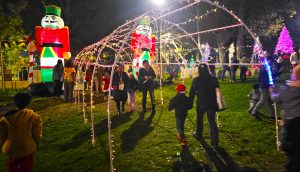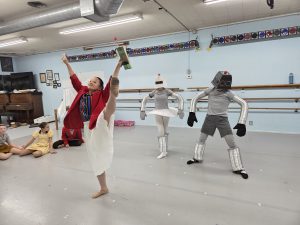January isn’t the end of the holiday season for Filipinos. It’s the time for one of the Philippines’ most important festivals: Santo Nino, the Holy Child Jesus. Our Lady of Peace church keeps this joyous tradition alive in Santa Clara, with its annual Santo Nino celebration, held the third Sunday in January.
Despite the afternoon’s downpour, the festival spirit wasn’t dampened, although the rain curtailed the traditional parade with the parish’s Santa Nino statue–a gift from the church’s former pastor, the late Monseigneur John Sweeney. Hundreds of worshippers filled the church sanctuary for a festive mass officiated by Father Brian Dinkel that featured traditional Filipino prayers and hymns to the Holy Child.
Families also brought their own Santo Nino statues to the celebration for a blessing, making a colorful and impressive display. There are many depictions of this beloved icon, which is familiar in Europe and the Americas as the Infant of Prague. Santo Nino is often dressed in red for blessings, or green for luck.
The mass was followed by a parish potluck featuring Filipino specialties, including pandesal, a traditional Filipino bread.
Dinner was followed by the Sinulog dance, dating back to the 16th century or possibly earlier. Tradition has it that if a woman who wants a baby dances the Sinulog she’ll conceive. The rocking motion of the dance is like rocking a baby, explained one dancer.
The Santo Nino is the oldest and most venerated Filipino Christian image. Ferdinand Magellan brought it to Cebu Island in 1521 and presented it to Queen Hara (Juana) of Cebu.
The queen reportedly danced with joy after receiving this gift, and this event is celebrated in the Sinulog dance. But after Magellan was killed in 1522, Spanish colonialism’s advance in the Philippines halted. No one knows the whereabouts of Queen’s beloved statue during the next 43 years.
In 1565, the Spanish returned. When the Cebuanos repulsed their attempt to colonize the island, the Spaniards opened fire and burned an entire coastal village. A soldier found the Santo Nino statue in the ruins of a house, unscathed by fire. This was judged to be a miracle and a church was built where the statue was found. The Catholic Church officially recognized the celebration of Santo Nino de Cebu in the 17th century.
Many miracles and miraculous powers are attributed to the Santo Nino statue. It’s said that when the Filipino capital was moved from Cebu to Manila in the 16th century, repeated attempts to move the Santo Nino to the new capital were thwarted by the statue’s disappearing en route and reappearing in Cebu.
The church housing the statue was bombed in WWII, but again, the Santo Nino escaped untouched. To this day, the Santo Nino is said to leave its glass case at night to protect travellers, returning in the morning with grass and mud on its shoes.
Most Filipino families have one or more Santo Ninos and, according to tradition, these domestic Santo Ninos like to go out to play at night, bringing home toys gathered during their nighttime rambling.
Santa Clara’s Our Lady of Peace parish has one of the largest Filipino-American congregations in the South Bay. The church is home to the Fil-Am Association, a group dedicated to preserving Filipino culture and religious tradition. Our Lady of Peace is also home to the Shrine of the Immaculate Heart of Mary, the 32-foot stainless steel statue of the Virgin Mary at Great America Parkway and Mission College Blvd.
For information about Our Lady of Peace, visit olop-shrine.org or call 408-988-4585. For information about Fil-Am, call Ernesto Camat (408) 373-8475 or Amy Acorda (408) 855-8485.











0 comments